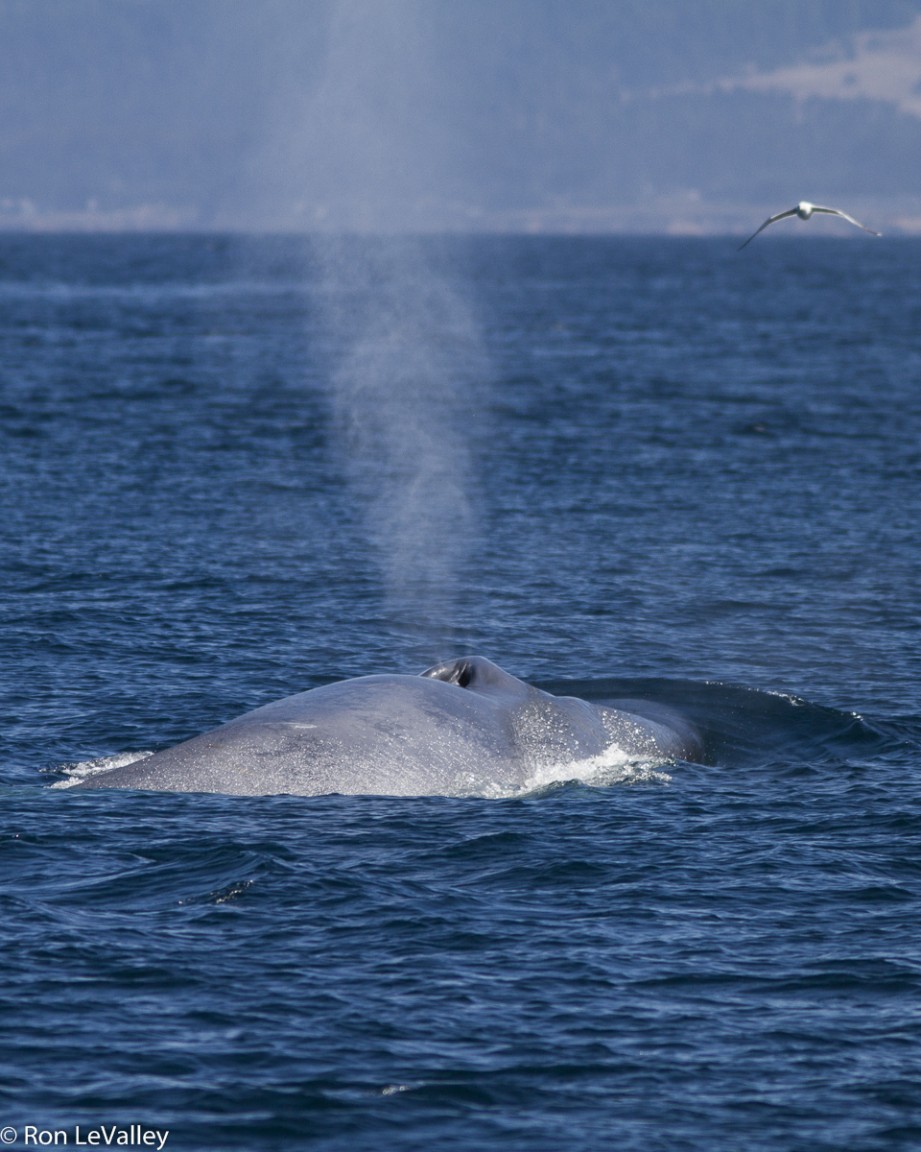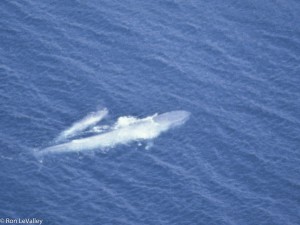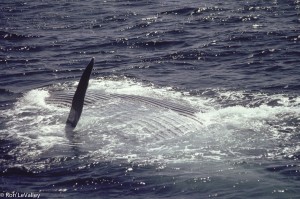Blue Whale Facts
- Order: Cetacea
- Suborder: Mysticete (Baleen)
- Family: Balaenopteridae
- Genus: Balaenoptera
- Species: musculus
- Status: Endangered throughout range
- Subspecies: Northern Hemisphere population
- Off our coast: June-October

The blue whale is the largest animal in the history of the earth! It’s heart is the size of a Volkswagen bug and the main aorta leaving the heart is large enough for a young child to crawl through. Most people don’t know that the Blue Whale primarily eats one of the smallest animals in the ocean – shrimp-like creatures called krill. They can’t swallow large prey because their throat is tiny in comparison – only 4 to 8 inches in diameter!

Click image to see BBC’s Planet Earth VIDEO segment on Blue Whales
Size and identification
Blue whales in the southern ocean can be over 100 feet long and weigh well over 150 tons. Here along the California coast, blue whales get to be up to 85 feet long. They are best identified by their tall, straight spouts (that can be up to 35 feet tall and hang in the air for much longer than other whale spouts) and their bluish-gray mottled skin. The other distinctive characteristic of the blue whale is a very long, streamlined body allowing relatively fast swimming speeds. When you see the spout and the whale is rolling at the surface, you will see a long back followed by a very small dorsal fin. Most other whales show the dorsal fin almost immediately after the spout. Blue whales will only occasionally raise their tail flukes at the end of a dive.

Barnacles
Blue whales have smooth skin with few or no barnacles. Rarely you might see a remora (a type of fish with a sucker on its head) or what we think is a small parasitic crustacean in the genus Pennella that looks like a tiny eel hanging off the dorsal fin or the tail flukes.
Migration and Breeding

Our blue whales along the Mendocino Coast are here from around June through October. During the winter they spend time in Baja California, off the coast of Mexico and as far south as Panama and Costa Rica. In these warmer waters the whales mate and about one year later females give birth. Females have calves about every 2-3 years and nurse them for about 7 months. When the blue whale calves are born they weigh about 6 tons and during the 7 months of nursing they will consume about 100 gallons of rich milk a day and gain as much as 8 pounds per hour! When they are weaned they will be over 50 feet long – the size of a humpback whale!
Feeding
After spending time in the warmer waters, the blue whales begin their northerly migration in late spring. Their migration pattern is not well known, but it appears they travel north until they find their favorite food – krill. Then they will stop and eat. If they find lots of krill, they might not migrate very far north. If they can’t find the krill then there is evidence that they can migrate up to the Gulf of Alaska looking for food. Blue Whales feed primarily on krill but are known to eat other crustaceans such as copepods and pelagic crabs and at times schooling fish.

Click image to see a VIDEO of a blue whale feeding
Blue whale feeding is the largest bio-dynamic event on the planet! Almost 1/4 of the body is made up of their wide, U-shaped head that is actually the upper lip! A blue whale will swim rapidly towards a dense school of krill, open its massive jaws when it encounters the school and then an enormous amount of water and krill will be gulped by its expanding mouth. This is possible because the throat is made up of multiple pleats that function like the bellows of an accordion allowing it to expand dramatically. These pleats extend from the tip of the mouth to the navel and allow the throat to expand enough to take in as much as 70 tons of water and krill! Then the whale uses it tongue to push the water out through its baleen, trapping the krill on the inside of its mouth. [Is there any danger that a blue whale might mistakenly swallow one of us??? Not likely as the whale’s esophagus is only about 4 to 8 inches in diameter making them well-suited to a diet of krill.]
Population Status
The blue whale has a truly global distribution, occurring in the Arctic Sea, Atlantic Ocean, Indian Ocean, and Pacific Ocean. In spite of their global distribution, they are one of the rarest of the whales, and most biologists consider them to be among the most endangered of the great whales. Only the eastern North Pacific off California is showing signs of real recovery, but our population still only includes about 2,000 animals currently.
When blue whales are off of our coast, they tend to stay out along the continental shelf, 8-15 miles offshore, but they are occasionally seen from land – so if you are here in the summer or early fall and the ocean is calm, keep your eyes out for that tall spout!
